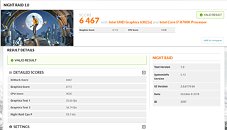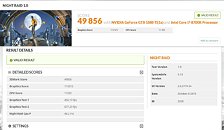- Joined
- Mar 25, 2009
- Messages
- 9,819 (1.70/day)
- Location
- 04578
| System Name | Old reliable |
|---|---|
| Processor | Intel 8700K @ 4.8 GHz |
| Motherboard | MSI Z370 Gaming Pro Carbon AC |
| Cooling | Custom Water |
| Memory | 32 GB Crucial Ballistix 3666 MHz |
| Video Card(s) | MSI RTX 3080 10GB Suprim X |
| Storage | 3x SSDs 2x HDDs |
| Display(s) | ASUS VG27AQL1A x2 2560x1440 8bit IPS |
| Case | Thermaltake Core P3 TG |
| Audio Device(s) | Samson Meteor Mic / Generic 2.1 / KRK KNS 6400 headset |
| Power Supply | Zalman EBT-1000 |
| Mouse | Mionix NAOS 7000 |
| Keyboard | Mionix |
With update 2.6.6174, released today, 3DMark now includes a new benchmark dubbed Night Raid. This latest addition to the popular 3DMark suite offers DX12 performance testing for laptops, tablets and other devices with integrated graphics. It also offers full support for ARM based processors in the latest always-connected PCs running Microsoft's Windows 10 on ARM. Users running 3DMark Basic Edition which is free will have access to this latest addition upon installing the update.
The Night Raid benchmark continues the trend of offering two graphics tests and a CPU test. While not as visually stunning as previous entries this is to be expected considering it is targeted at integrated graphics processors and entry level systems. Even so, it makes use of numerous graphical features with graphics test 1 including; dynamic reflections, ambient occlusion, and deferred rendering. Graphics test 2 features; tessellation, complex particle systems and depth of field effects with forward-rendering. Finally, the CPU test will measures performance through a combination of physics simulation, occlusion culling, and procedural generation.


Having run the benchmark on two systems the results are interesting, to say the least. While the NVIDIA GeForce 1080 Ti system easily manhandled the benchmark the fact the Intel IGP was able to render it and with better than expected frame rates was quite a surprise. While the Intel UHD graphics 630 in the Core i7-8700K doesn't have enough grunt to run the benchmark at perfectly fluid frame rates it still does well. The Night Raid benchmark appears to be a solid option for those looking to determine the performance of modern low power or entry level hardware with a modern API. That said, what are your thoughts and scores? Let us know in the comments below!


For a quick look at the benchmark in action you can view the trailer below.
View at TechPowerUp Main Site
The Night Raid benchmark continues the trend of offering two graphics tests and a CPU test. While not as visually stunning as previous entries this is to be expected considering it is targeted at integrated graphics processors and entry level systems. Even so, it makes use of numerous graphical features with graphics test 1 including; dynamic reflections, ambient occlusion, and deferred rendering. Graphics test 2 features; tessellation, complex particle systems and depth of field effects with forward-rendering. Finally, the CPU test will measures performance through a combination of physics simulation, occlusion culling, and procedural generation.


Having run the benchmark on two systems the results are interesting, to say the least. While the NVIDIA GeForce 1080 Ti system easily manhandled the benchmark the fact the Intel IGP was able to render it and with better than expected frame rates was quite a surprise. While the Intel UHD graphics 630 in the Core i7-8700K doesn't have enough grunt to run the benchmark at perfectly fluid frame rates it still does well. The Night Raid benchmark appears to be a solid option for those looking to determine the performance of modern low power or entry level hardware with a modern API. That said, what are your thoughts and scores? Let us know in the comments below!


For a quick look at the benchmark in action you can view the trailer below.
View at TechPowerUp Main Site




